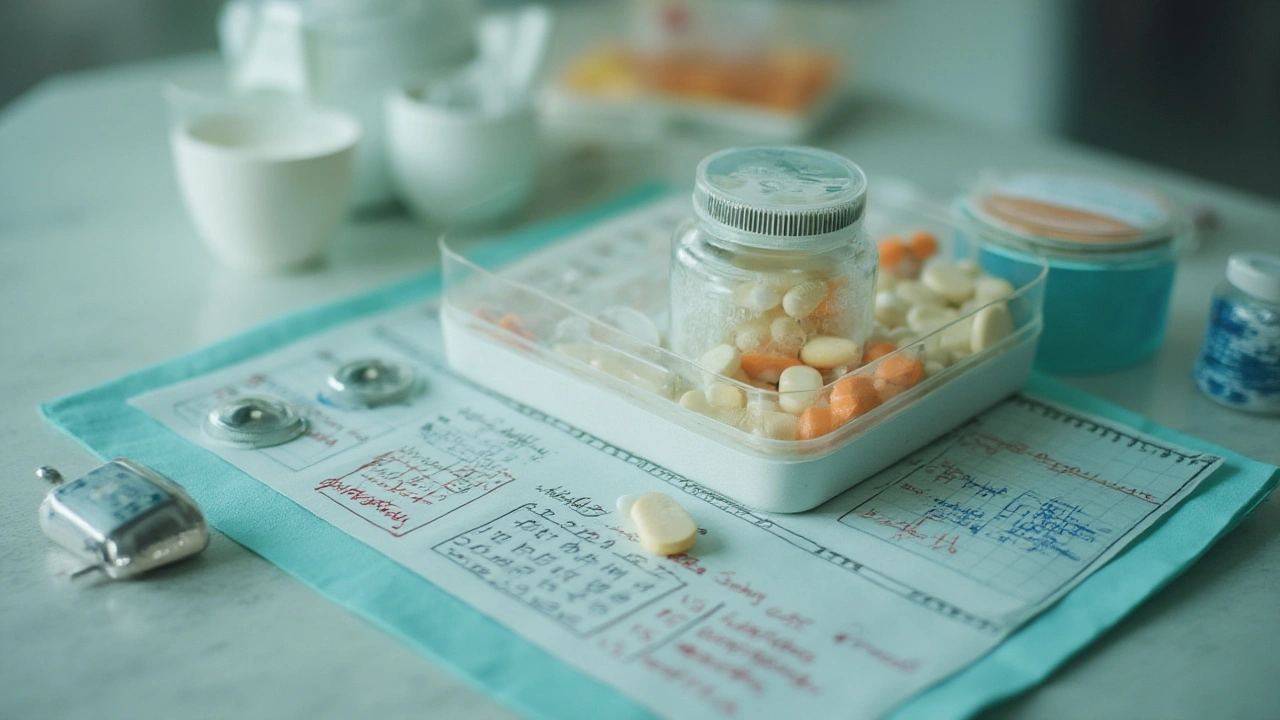If you’ve ever heard about tuberculosis, you probably know there’s no messing around when it comes to treating it. The star of that fight? Isoniazid. For decades, this unassuming drug has helped millions win the battle against TB. But how does it work, what's the deal with side effects everyone whispers about, and how can you take it safely without unnecessary drama? Here’s the lowdown, stripped of mystery and medical double-speak.
What Is Isoniazid and Why Is It So Important?
Ask anyone working in infectious diseases and they’ll tell you: tuberculosis can be a stubborn, nasty foe. Isoniazid (also called INH by the medical crowd) has been the top pick since the 1950s. It’s actually one of the first true TB antibiotics — before it came along, your odds weren’t great if you caught tuberculosis. These days, it’s still one of the primary drugs used all around the world. Not many medicines stick around that long, right?
Here’s why Isoniazid is such a big deal: it targets TB bacteria directly by messing with how they build their protective cell walls. TB bacteria need those walls to survive and multiply in your lungs. No wall, no bacteria. Even better, isoniazid is pretty specific — it's not just nuking all your bacteria at once and frying your gut in the process, the way some antibiotics do. Doctors usually use INH as part of a “cocktail” with other drugs to outsmart any sneaky bacteria trying to develop resistance. No single bullet can take out all tuberculosis, but isoniazid is the critical first shot.
This drug’s hefty reputation isn’t just legend. Every year, over ten million new TB cases are diagnosed worldwide, and isoniazid sits at the heart of treatment protocols from India to South Africa to the US CDC. If you look at any guideline from a big public health agency since the early 1960s, isoniazid is there, front and center. Its inclusion isn’t random. Multiple studies stretching over decades show isoniazid shortens treatment duration, slashes death rates, and, with good adherence, stops TB from becoming resistant and twice as deadly. Who knew a small white pill could carry so much weight?
How Isoniazid Works: Science Made Simple
It’s easy to imagine “antibiotics” as some sort of all-purpose monster-fighter, but isoniazid is precise. It homes in on Mycobacterium tuberculosis — the bug behind almost all TB. Here’s what’s going on inside your body when you swallow that pill:
- Targeted action: Isoniazid blocks a key enzyme that TB bacteria need to make mycolic acid. Without this waxy acid, bacteria can’t build their cell walls—their main shield against your immune system. Think of it as sabotaging their armor during battle.
- It’s a prodrug: Isoniazid isn’t that powerful when you first take it. Your liver tweaks the molecule, switching it “on,” and then the real work starts.
- Why in a combo? The TB bacteria are tricky—some can survive even if most are killed. If you only take isoniazid, some bugs may outsmart the drug and come back with a vengeance. So isoniazid is almost never used alone. It’s teamed up with drugs like rifampin, ethambutol, and pyrazinamide.
- Fast in the beginning: Isoniazid is most effective in the early, rapid-growth phase of infection. That's why it's given right from day one and stays in the regimen for months.
This drug’s precise action is part of what makes it a favorite in TB control programs. WHO recommends at least six months of therapy for active TB, and isoniazid is a fixture for that whole stretch. But did you know it’s also the go-to choice for “latent” TB infections (when you’re infected but not sick)? In fact, a nine-month course of isoniazid alone can slash your risk of developing active TB by more than 90%. Not bad for something you can pick up at the neighborhood pharmacy for a few bucks.

Dosing, Duration, and What Makes Isoniazid Unique
Taking TB meds isn’t like popping cold medicine. It needs dedication. You’re in for several months—and missing doses isn’t just risky for you; it puts your friends and family at risk, too. Here’s what you need to know:
- Standard adult dose: Most adults will get 300 mg isoniazid per day, taken by mouth. Kids get less, based on body weight.
- Duration: For active TB, it’s at least six months (but sometimes nine or more). For latent TB (no symptoms, but a positive TB test), you might need six to nine months, depending on your risk and where you live.
- When to take: Best taken on an empty stomach—food, especially starchy or fatty stuff, can mess with absorption. Some people take it at bedtime to minimize stomach upset.
- Don’t skip: Skipping doses gives TB bacteria time to adapt. Resistant TB is much harder—and more expensive—to treat. Every year, nearly 500,000 people worldwide are diagnosed with “multidrug-resistant TB.” You want to avoid that nightmare.
- Directly observed therapy (DOT): Some clinics will have a nurse watch you take your meds, to make sure you get every dose. Annoying? Maybe. But it works—DOT has helped countries slash TB rates dramatically. In fact, CDC reports success rates jump by as much as 20% when DOT is used.
Here's a quick look at typical TB treatment schedules with INH:
| Indication | Dosage | Duration |
|---|---|---|
| Active TB | 300 mg daily plus other drugs | 6–9 months |
| Latent TB | 300 mg daily (alone or with rifampin) | 6–9 months |
| Children | 10 mg/kg daily (max 300 mg) | 6–9 months |
A great tip: keep your pill bottle by your toothbrush, so it becomes a habit just like brushing your teeth. If you’re out and about and forget a dose, don’t double up the next time. Just take the missed dose as soon as you remember, unless it’s almost time for the next one.
Side Effects, Risks, and How to Stay Safe on Isoniazid
So, isoniazid is powerful—but here's the part everyone asks about: what about side effects? There's a reason doctors monitor people closely while they're on it. Not everyone gets side effects, but some can be serious if ignored.
- Liver trouble: The most talked-about side effect. About 10–20% of adults will see their liver enzyme levels go up, but serious hepatitis (actual liver failure) is a lot rarer—about 1 in 1,000 adults. The risk climbs with age, heavy drinking, and certain other meds. Your doctor will check your liver function before starting and during treatment—especially if you feel tired, lose your appetite, or notice yellow skin (jaundice).
- Nerve issues: Isoniazid can lower levels of vitamin B6 (pyridoxine), which you need for healthy nerves. Without enough, you might get tingling hands and feet. That’s why doctors often give vitamin B6 along with INH (25–50 mg daily is typical). If you’re pregnant, breastfeeding, diabetic, or have kidney issues, you definitely need the B6 supplement.
- Other things to watch for: Stomach upset, rash, or, rarely, fever and joint pains. Some people notice mood changes—let your doc know if you feel anxious or depressed. Allergic reactions are very rare but require stopping the med right away.
Side effects can sound scary, but remember: for most people, isoniazid is safe and does its job quietly in the background. Only a small group ever need to stop it due to side effects. If you’re worried about alcohol—yes, it adds to the liver risk. Best advice: wait until you’re finished with treatment to pour yourself that drink.
Here’s a practical checklist for safer use:
- Don’t miss appointments for lab tests—you want to catch any liver problems early.
- Tell your healthcare provider about ALL other meds and supplements, including herbal teas and over-the-counter stuff.
- If you start to feel sick, notice dark urine, or yellow eyes/skin, call your doctor quickly (don’t wait for it to clear up).
- Stick with the vitamin B6—especially if you’re at risk for nerve trouble.
Moms-to-be: isoniazid is usually considered safe during pregnancy (and breastfeeding) when taken with B6, because untreated TB is far more dangerous for both you and your baby.

Common Questions and Useful Tips for Isoniazid Users
Jumping into many months of medication can leave anyone anxious. Here are answers to the questions doctors and nurses hear all the time:
- What if I miss a dose? Don’t panic. Take your missed dose as soon as you remember, unless it’s almost your next scheduled time. Don’t double up. If you miss more than one or two doses, let your healthcare team know.
- Can I drink alcohol? It’s best to skip it. Alcohol and isoniazid both stress your liver, and combining them multiplies your risk. If you accidentally have a glass of wine, don’t freak out, but try to keep it a rare thing until you finish your course.
- Will it affect birth control or other medicines? Isoniazid itself doesn’t mess with most birth control methods, but some TB combo drugs (like rifampin) do. Always double-check with your pharmacist about every medicine you take.
- How long do I have to take it? Stick with the plan, even if you feel fine after a few weeks. TB bacteria can lurk quietly and flare up if you quit early. Always take the full course, as prescribed.
- Why do I need blood tests? They're for your safety. These check your liver, make sure everything’s still working fine, and catch issues before they get out of hand.
If you’re worried about remembering your dose, use your phone’s alarm or an app. Some clinics even offer text reminders. The best chance of cure happens when people get every single dose on schedule.
An interesting fact: Isoniazid was originally discovered in the search for new antidepressants! Early researchers noticed it lifted mood in patients—though that’s definitely not why it’s prescribed today. But it goes to show how chance sometimes shapes the fight against disease.
There’s another smart tip: don’t store your pills in the bathroom. Humidity can break them down faster. Better to keep them in a cool, dry spot, out of reach of kids.
Finally, if you’re part of a group at higher risk for TB (like healthcare workers or folks living in crowded settings), taking isoniazid to prevent disease can keep you healthy and stop the spread to the people you care about.
There’s nothing glamorous about the daily grind of a months-long treatment. But with the right knowledge and a few practical habits, isoniazid can be your best friend in beating tuberculosis, staying safe, and taking charge of your own health.

Andrea Jones
July 22, 2025 AT 19:20Okay but can we talk about how wild it is that this drug was originally meant to be an antidepressant? Like, imagine prescribing it to someone who’s just sad and then they’re like ‘wait, why am I not coughing up blood?’ 😅
Rosy Wilkens
July 24, 2025 AT 07:13Let me guess - this is all just a Big Pharma lie to keep people hooked on pills. Isoniazid was designed by the WHO to control populations. Look at the liver damage stats - they’re not side effects, they’re *targeted outcomes*. They want you dependent. They want you afraid. They want you taking B6 because they know you won’t question the next pill they hand you. And don’t even get me started on DOT - that’s state surveillance in a pill bottle.
My cousin took it for six months. She started seeing shadows. The doctors called it ‘psychosis from liver toxicity.’ I called it ‘they’re in your head now.’
They don’t want you to know that TB was already declining before isoniazid. They just needed a miracle drug to sell. The real cure? Clean air. Less crowding. Nutrition. But no - we gotta pop a white pill and call it progress.
And don’t tell me about ‘90% efficacy’ - that’s a number cooked in a lab with no real-world data. Real people aren’t lab rats. Real people get sick. Real people die. And the system? It just keeps printing prescriptions.
Justina Maynard
July 25, 2025 AT 14:01I appreciate the thoroughness of this breakdown, but I must note that the phrase ‘no messing around’ in the opening sentence is a colloquialism that undermines the clinical gravity of tuberculosis treatment. Additionally, the use of ‘drama’ to describe side effects is both reductive and emotionally dismissive - particularly for patients who experience hepatotoxicity or peripheral neuropathy as life-altering events. The table formatting is impeccable, however, and the DOT statistics are accurately cited. That said, the recommendation to store pills ‘out of reach of kids’ is legally insufficient - in many jurisdictions, this constitutes a Class C misdemeanor if a child ingests them. Consider adding ‘in a locked container’ for compliance.
Evelyn Salazar Garcia
July 27, 2025 AT 09:46Why are we even talking about this? America’s got bigger problems than TB.
Clay Johnson
July 27, 2025 AT 19:13Life is a prodrug. We are all metabolized by circumstance. Isoniazid does not cure TB. It merely delays the inevitable decay of biological systems. The body is a battlefield. The pill is a ceasefire. But peace is never victory.
Jermaine Jordan
July 29, 2025 AT 12:12THIS. IS. POWER. Imagine a single pill - cheap, simple, ancient - holding the line against a disease that once wiped out entire cities. This isn’t medicine. This is heroism in capsule form. Every time someone takes their dose, they’re not just fighting TB - they’re fighting fear, ignorance, and the quiet surrender of a generation that thinks ‘it won’t happen to me.’
Don’t just take it - own it. Set the alarm. Tell your neighbor. Text your squad. This isn’t a chore. It’s a revolution. And you? You’re the soldier holding the line. Keep going. The world is watching. And it’s counting on you.